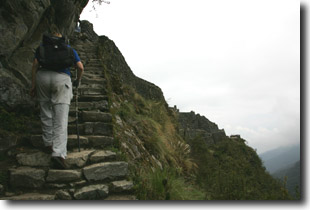 |
 |
Training for Changing Elevation
 If your trek involves climbing or descending significant elevations, you need to prepare your body for climbing, descending, or both.
If your trek involves climbing or descending significant elevations, you need to prepare your body for climbing, descending, or both.
Typically, there are three types of treks. The most traditional is to both climb and descend along the trek. Some treks, like the Everest Base Camp trek, start by primarily ascending till you reach a peak and then finish by primarily descending until you return to the starting location. Others, like the Grand Canyon, start by descending to the river and then climbing back out. Regardless of which order you ascend and descend, it’s important to vary your training to work the muscles and joints used as you climb and descend.
If you have varied terrain near where you live, that is the ideal training topography. By walking one of your longer walks up and down a hills trail, you simulate the conditions of your trek and work both the muscles needed for down hills as well as up hills.
Since most of us do not have access to the perfect training grounds we must simulate it. One might think a stair master is appropriate. However, it’s far from ideal. A stair master allows you to simulate walking up, but not down a hill. Most people don’t realize that walking down hill actually is more destructive to the body. This is for two reasons. First, there is more force on the body as you go down hill, especially with weight on your pack. Second, as you descend, the muscles elongate in what’s called an eccentric contraction. These types of contractions, when stressed, break down the muscle more than the concentric contractions caused by walking uphill.
A better solution is to simulate your hill training by climbing up and down flights of stairs. Ideally, walking up a few flights and then back down a few. Repeating the process a number of times.
I typically start my training for a hard trek by climbing and descending about 20 flights of stairs. Then, I gradually build up to about 100 flights. This number is highly subjective as flights vary in size and the amount of elevation you may climb in a day varies greatly. However, 100 flights is a reasonable goal that if reached accomplishes a good base to prepare your hike. Once or twice a week I substitute my walking miles for this type of stair exercise. Typically, I start without a pack on my back, but as the time for the trek nears, I wear the same pack I will during my trek and load it to the approximate weight it will be during the trek.
When walking up and down steps, try to vary which leg you lead with as well as whether you take one or two steps in a stride. By varying your step you greater simulate real world conditions. It’s usually not the case that you can walk with a consistent exact stride. Sometimes you have to step over large rocks or reach down to a flat area. The more you simulate the conditions experienced on the trail the better prepared you will be.
